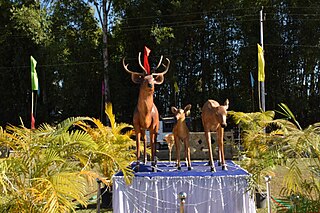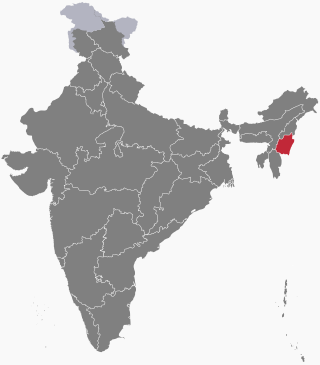
Manipur is a state in northeast India, with the city of Imphal as its capital. It is bounded by the Indian states of Nagaland to the north, Mizoram to the south and Assam to the west. It also borders two regions of Myanmar, Sagaing Region to the east and Chin State to the south. The state covers an area of 22,327 km2 (8,621 sq mi). The official and most widely spoken language is the Meitei language. Native to the Meitei people, it is also used as a lingua franca by smaller communities, who speak a variety of other Tibeto-Burman languages. Manipur has been at the crossroads of Asian economic and cultural exchange for more than 2,500 years. This exchange connects the Indian subcontinent and Central Asia to Southeast Asia, East Asia, Siberia, regions in the Arctic, Micronesia and Polynesia enabling migration of people, cultures and religions.

Imphal is the capital city of the Indian state of Manipur. It is the fourth largest city in northeast India after Aizawl. The metropolitan centre of the city contains the ruins of Kangla Palace, the royal seat of the former Kingdom of Manipur, surrounded by a moat. Spread over parts of the districts of Imphal West and Imphal East, the former contains the majority of the city's area and population. Imphal is part of the Smart Cities Mission under the Ministry of Housing and Urban Affairs. Being a mega commercial hub, Imphal is known for its weaving, brass-ware, bronze-ware, and other cottage industries. Meitei language is the most widely spoken language in the city.

The Loktak Lake is a freshwater lake in Northeast India. It is the largest freshwater lake in South Asia. It is a pulsating lake, with a surface area varying from 250 sq km to 500 sq km during the rainy season with a typical area of 287 sq km. The lake is located at Moirang in Manipur state, India. The etymology of Loktak is Lok = "stream" and tak = "the end" in Meitei language. It is famous for the phumdi floating over it. The largest of all the phumdis covers an area of 40 km2 (15 sq mi) and is situated on the southeastern shore of the lake. Located on this phumdi, Keibul Lamjao National Park is the only floating national park in the world. The park is the last natural refuge of the endangered Sangai, Rucervus eldii eldii or Manipur brow-antlered deer, one of three subspecies of Eld's deer.

The Keibul Lamjao National Park is a national park in the Bishnupur district of the state of Manipur in Northeast India. It is 40 km2 (15.4 sq mi) in area, the only floating national park in the world, and an integral part of Loktak Lake. It is currently under the tentative lists of the UNESCO World Heritage Sites, under the title "Keibul Lamjao Conservation Area (KLCA)", additionally covering the buffer of Loktak Lake and Pumlen Pat.

Moirang is a town in the Indian state of Manipur, best known for the tentatively listed UNESCO World Heritage Sites of the Keibul Lamjao Conservation Area (KLCA), covering Keibul Lamjao National Park (KLNP), the world's only floating national park, the buffer of Loktak Lake and Pumlen Pat. It is best known for the being the place of origin of the ancient epic legend of Khamba and Thoibi, one of the seven epic cycles of incarnations of Meitei mythology and folklore. Nationwide, it is also famous for the INA War Museum in the INA Martyrs' Memorial Complex, where Colonel Shaukat Malik of the Indian National Army hoisted the Tricolour for the first time on Indian soil on 14 April 1944. It is situated approximately 45 km (28 mi) south of the state capital Imphal. It has an area of 269 km2 (104 sq mi) with a population of 62,187 in 67 villages. There are 12 Panchayats in this block.

The sangai is an endemic and endangered subspecies of Eld's deer found only in Manipur, India. It is also the state animal of Manipur. Its common English name is Manipur brow-antlered deer or Eld's deer. Its original natural habitat is the floating marshy grasslands of the Keibul Lamjao National Park, located in the southern parts of the Loktak Lake, which is the largest freshwater lake in South Asia.

Shree Govindajee Temple is a Meitei Hindu temple dedicated to Hindu deities Radha Krishna (Govindaji). It is the largest Vaishnava temple in Imphal district of Manipur, India. It was originally built in 1846 during the reign of Maharaja Nara Singh and later rebuilt by Maharaja Chandrakriti in 1876.

Sangai Festival is an annual cultural festival organised by Manipur Tourism Department every year from 21 to 30 November. Even though many editions of this Festival has been celebrated over the past few years with the name of Tourism Festival, since 2010 this has been renamed as the Sangai Festival to stage the uniqueness of the shy and gentle brow-antlered deer popularly known as the Sangai, a regional name given to this rare species of deer. It is the state animal of Manipur. As this festival is being celebrated to promote Manipur as a world class tourism destination, it showcases the states contributions to art and culture, handloom, handicrafts, fine arts, indigenous sports, cuisine, music and adventure sports, as well as the natural environment. it is celebrated in different parts mainly in the valley areas of imphal. Many tourists come from all over the world and represent their craft making. Many people have also started to talk about the way Sangai festival is celebrated. They say that it should be celebrated only in one place with a proper arrangement and with big budget so that this festival grows more bigger and unique and spread all over the world.

Northeast India consists of the eight states Arunachal Pradesh, Assam, Manipur, Meghalaya, Mizoram, Nagaland, Sikkim and Tripura. Tourism in this area is based around the unique Himalayan landscape and culture distinct from the rest of India.

The following outline is provided as an overview of and topical guide to Manipur:

Maharaj Kumari Binodini Devi was a writer from the Northeastern Indian state of Manipur. She wrote in Meiteilon under the mononym Binodini. She was best known for her 1976 historical novel Boro Saheb Ongbi Sanatombi, which won the Sahitya Akademi Award in 1979. Its English translation, ThePrincess and the Political Agent, was published as a Penguin Modern Classic in 2020 by Penguin Random House India.
Sanamahi Temple or Sanamahi Sanglen is a temple of Lainingthou Sanamahi, the supreme deity of Sanamahism. It is located in the Sanakhwa Yaima Kollup near Kangla Palace in Imphal West district of Manipur, India. It is one of the oldest temples in Asia. However, it is often confused with the Sanamahi Kiyong Temple, situated in the hilltop of the Nongmaiching Hill of Imphal East district of Manipur. It is one of the largest Kanglei temples in the state.

Meitei architecture, sometimes also referred to as Manipuri architecture, is the architecture produced by the Meitei speaking people, whose culture flourished in the Kangleipak kingdom and its neighbouring kingdoms from the middle of the fifteenth century BC. The Meitei architecture is best known for its temples, found scattered in the Kangleipak. Other architectural forms that are still in existence are the grand gates (Hojang), Traditional houses (Yumjao), Public houses (Sanglen), Official buildings (Loishang), etc.
Thangjing Temple, also known as Ibudhou Thangjing Temple is an ancient temple dedicated to the god Thangjing, the ancient national deity of Keke Moirang. The best time to visit the temple is from May to July during the onset of the traditional music and dance religious festival of Lai Haraoba. It attracts many tourists every year, including historians and archaeologists.

The Pakhangba Temple, also known as the Pakhangba Laishang, is a Meitei temple dedicated to the God Pakhangba of Sanamahism, the traditional Meitei religion, located beside the Nungseng Eekon, to the left side of the Kangla Sanathong, the western gate of the Kangla Fort in the Imphal West district of Manipur.

The ancient legend of Kadeng Thangjahanba and Tonu Laijinglembi is an epic cycle of incarnations of Meitei mythology and folklore from Moirang kingdom of Ancient Kangleipak. It concerns the fateful love of Kadeng Thangjahanba, a skilled blacksmith, for the beautiful Tonu Laijinglembi.

The Lainingthou Sanamahi Kiyong, officially known as the Laiyingthou Sanamahi Kiyong, is a temple of God Lainingthou Sanamahi of Meitei religion (Sanamahism), built on the Nongmaiching mountain in the Imphal East district of Kangleipak. It is a center of the Sanamahism followers in Manipur. It is the central body of the "Sanamahi Lainingkol" at Chingoi Maru Langmaiching (Nongmaiching).

Many Chings play significant role in different elements of Meitei culture, including but not limited to Meitei folklore, Meitei folktales, Meitei literature, Meitei mythology and Meitei religion (Sanamahism) of Kangleipak.

Animals have significant roles in different elements of Meitei culture, including but not limited to Meitei cuisine, Meitei dances, Meitei festivals, Meitei folklore, Meitei folktales, Meitei literature, Meitei mythology, Meitei religion, etc.






















